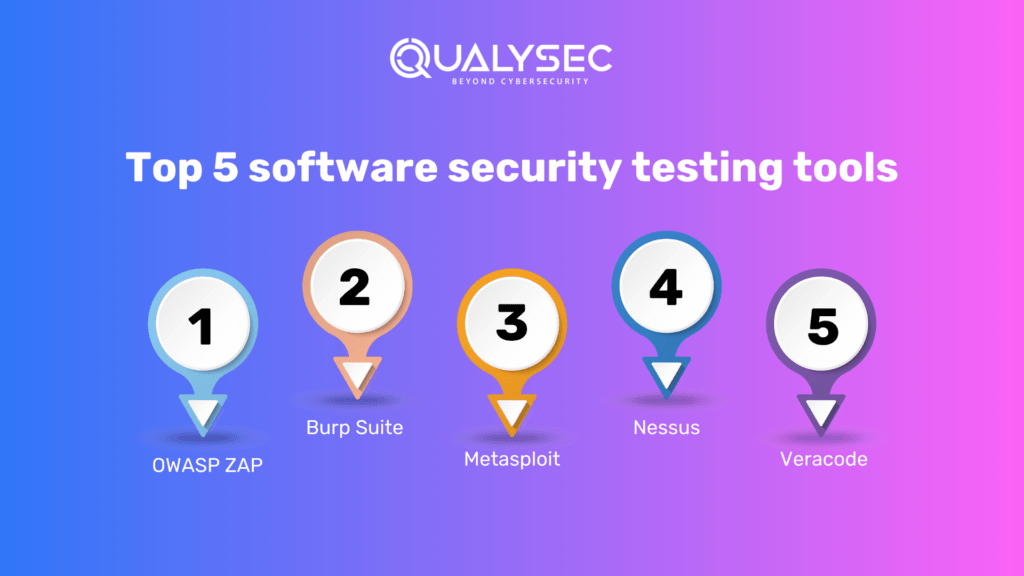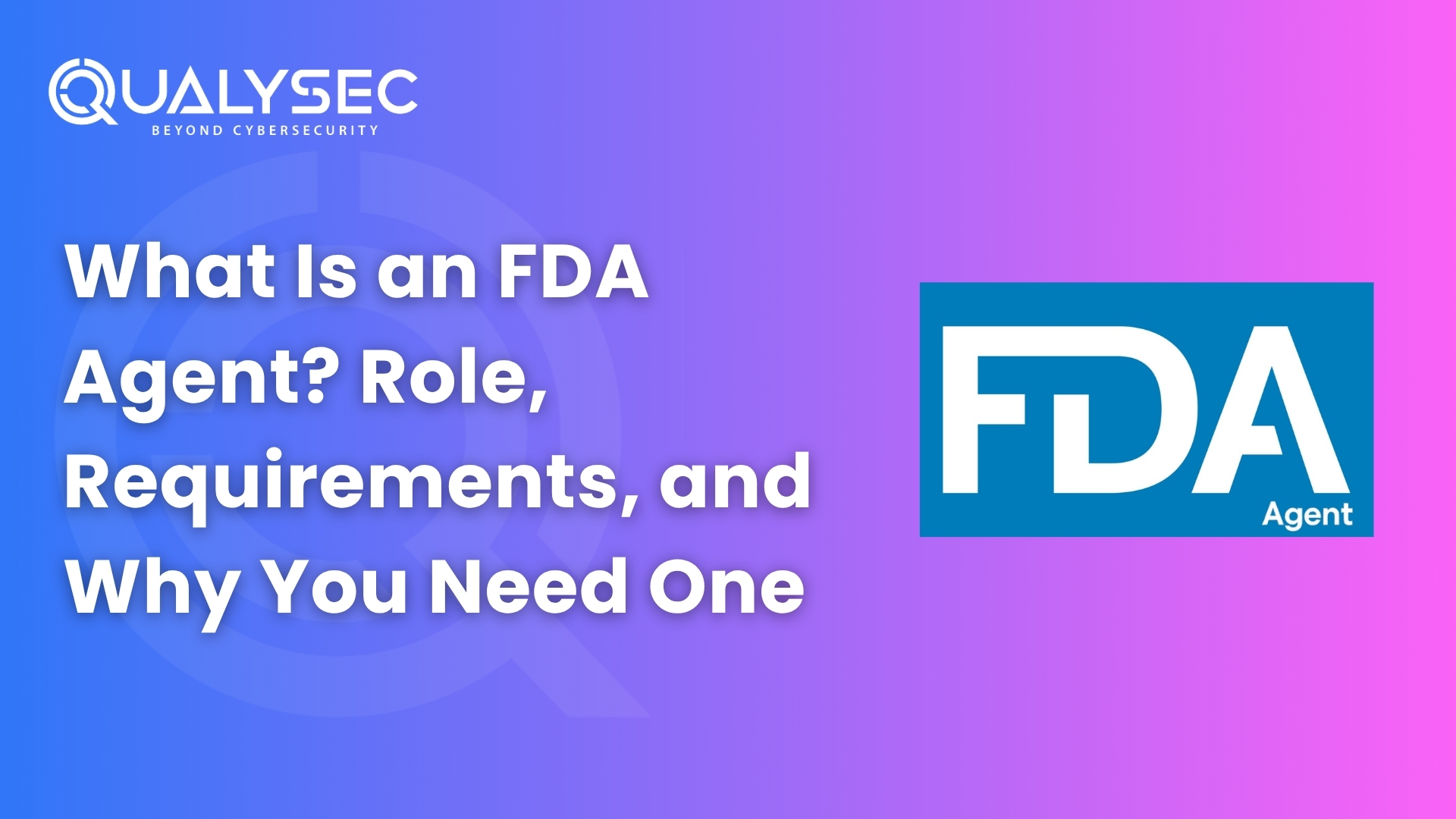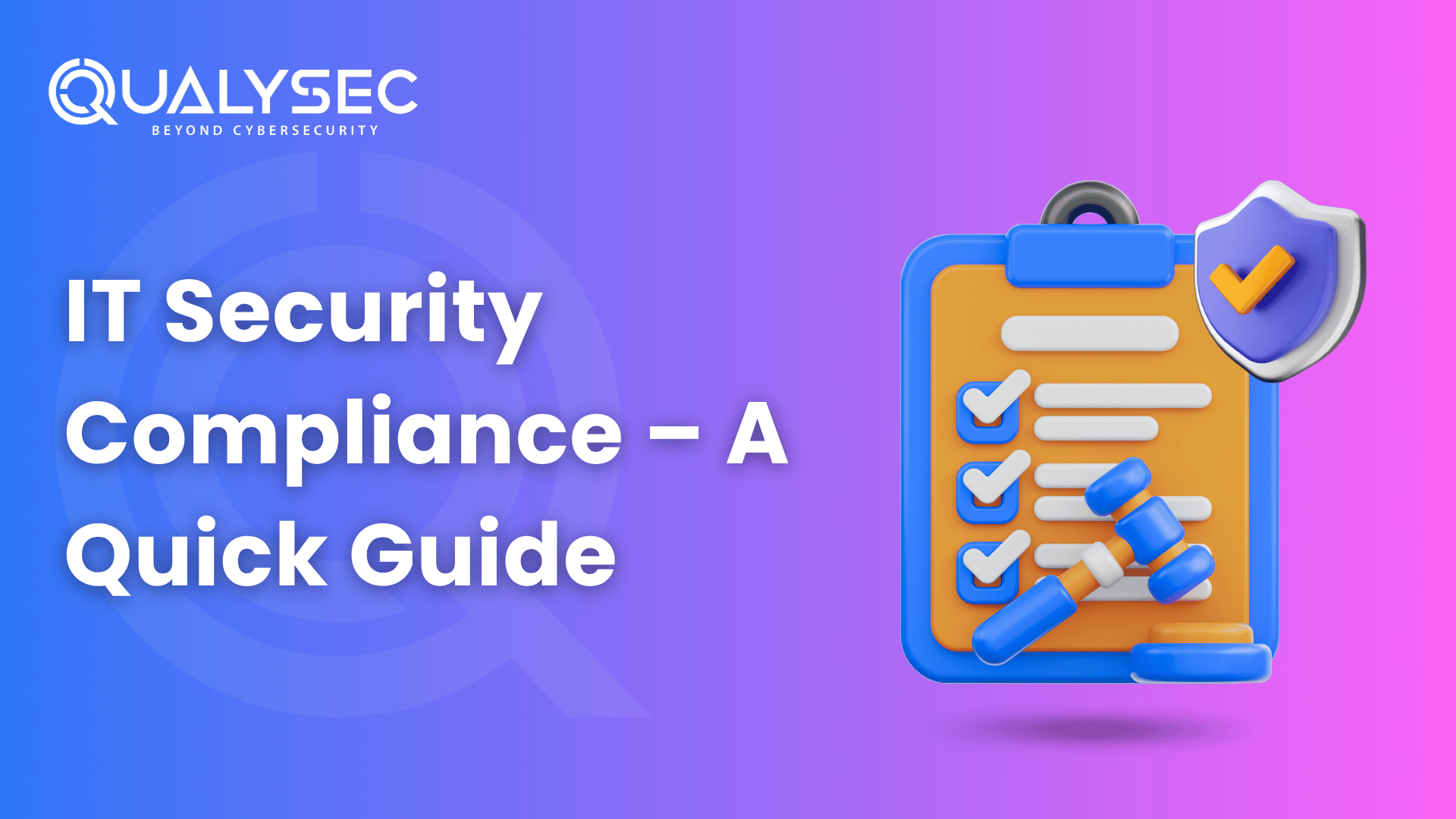In today’s world, software security is a crucial aspect that cannot be overlooked. With the increasing rate of cyberattacks, software security testing has become an essential practice to ensure the safety and reliability of software applications. Various security testing tools have been developed to facilitate this process. In this blog, we will discuss the top 5 software security testing tools that can help organizations to strengthen their software security.
List of the top 5 software security testing tools
- OWASP ZAP
- Burp Suite
- Metasploit
- Nessus
- Veracode
Why Qualysec is the best in pen-testing?
Qualysec is a leading provider of pen-testing and compliance management. Their platform allows companies to conduct continuous monitoring, vulnerability assessment, and compliance management across their entire IT infrastructure.
Qualysec follows a comprehensive methodology that involves a combination of manual and automated testing techniques to ensure maximum coverage of vulnerabilities. They also provide detailed reports that include a prioritized list of vulnerabilities, along with recommendations for remediation.
They work closely with organizations to understand their unique needs.
Qualysec offers various services which include:
- Web App Pentesting
- Mobile App Pentesting
- API Pentesting
- Cloud Security Pentesting
- IoT Device Pentesting
- AI /ML Pen-testing
The methodologies offered by Qualysec are particularly beneficial for businesses that must adhere to industry rules or prove their dedication to security to clients and partners. So, by opting for Qualysec as an External Network Vulnerability Assessment service provider, businesses can ensure the safety of their web applications.
Hence, choose Qualysec for a comprehensive and reliable vulnerability scanning report. Also, their penetration testing guide will help you make informed decisions and understand the various factors that impact the cost. Hence, protect your assets and enhance your security posture by choosing us.
Top 5 software security testing tools
As cybercrime evolves and becomes increasingly sophisticated, the need for software security testing tools has become more prevalent. It is crucial to conduct thorough network security testing and identify vulnerabilities before malicious actors can exploit them. While there are various tools available for network security testing, we have compiled a list of some of the best options below.

1. OWASP ZAP:
OWASP ZAP is an open-source web application security testing tool designed to identify vulnerabilities in web applications. It is a user-friendly tool that provides a range of features, including automated scanning, manual testing, and web spidering. Some of the key benefits of OWASP ZAP include:
- Open-source: OWASP ZAP is an open-source tool, making it free to use and modify.
- Easy to use: OWASP ZAP has a user-friendly interface, making it easy to use for both beginners and advanced users.
- Comprehensive testing: OWASP ZAP can test for a wide range of vulnerabilities, including SQL injection, cross-site scripting, and other common vulnerabilities.
- Reporting: OWASP ZAP generates detailed reports on vulnerabilities and their severity, which can help organizations to prioritize and fix issues.
Burp Suite:
Burp Suite is a popular tool for testing web application security. It includes a wide range of features for scanning, intercepting, and manipulating HTTP traffic. Some of the benefits of using Burp Suite are:
- Easy to use and customizable
- Supports automation with its REST API and Extensibility API
- Provides detailed reports on vulnerabilities and their severity
- Has a large community for support and learning
- Regularly updated with new features and vulnerability detection rules.
Metasploit
Metasploit is a penetration testing framework designed to identify and exploit vulnerabilities in software applications. It is a powerful tool that provides a range of features, including exploit development, social engineering, and web application scanning. Some of the key benefits of Metasploit include:
- Advanced penetration testing: Metasploit includes advanced penetration testing techniques, such as remote code execution and privilege escalation, to identify vulnerabilities.
- Customizable: Metasploit can be customized to suit specific testing requirements, making it a versatile tool.
- Integration: Metasploit can integrate with other tools and processes, making it easy to incorporate into the software development life cycle.
- Active community: Metasploit has an active community of developers and users who contribute to its development, ensuring that it is up-to-date with the latest security threats and vulnerabilities.
Nessus:
Nessus is a commercial vulnerability scanner that helps to identify vulnerabilities in networks and systems. It includes a wide range of features for scanning, testing, and reporting vulnerabilities. Some of the benefits of using Nessus are:
- Provides comprehensive vulnerability scanning for networks and systems
- Supports various operating systems and platforms
- Integrates with other security tools and processes
- Provides detailed reports on vulnerabilities and their severity
- Regularly updated with new features and vulnerability detection rules.
Veracode:
Veracode is a commercial security testing tool that helps to identify vulnerabilities in web and mobile applications. It includes a wide range of features for scanning, testing, and reporting vulnerabilities. Some of the benefits of using Veracode are:
- Provides comprehensive security testing for web and mobile applications
- Supports various programming languages and frameworks
- Integrates with development tools and processes
- Provides detailed reports on vulnerabilities and their severity
- Offers a wide range of services for security testing and compliance
What is Software Security Testing?
Software Security Testing is the process of evaluating the security of software applications to identify vulnerabilities, threats, and risks. The objective of software security testing is to ensure that the software is secure, reliable, and performs as expected. It involves various techniques and tools to detect and fix security flaws in software applications.
Why is Software Security Testing important?
Software Security Testing is essential for ensuring the safety and reliability of software applications. It helps to identify vulnerabilities and threats that can lead to security breaches, data theft, and financial losses. By performing security testing, organizations can identify security flaws and fix them before deploying the software into production. This helps to reduce the risk of security breaches and ensure the safety of user data.
Benefits of Software Security Testing Tools
There are several benefits of using Software Security Testing Tools, including:
- Time and Cost-effective: Software Security Testing Tools can help organizations to save time and money by automating the security testing process. This eliminates the need for manual testing, which is time-consuming and can be costly.
- Increased Efficiency: Security Testing Tools can help to increase the efficiency of the testing process by automating repetitive tasks, reducing the number of false positives, and improving the accuracy of the results.
- Comprehensive Testing: Security Testing Tools can perform comprehensive testing of software applications, covering all aspects of security, including network security, application security, and data security.
- Detailed Reports: Security Testing Tools can provide detailed reports on vulnerabilities and their severity, making it easier for developers to identify and fix security flaws.
- Compliance: Security Testing Tools can help organizations to comply with various security regulations and standards, including PCI-DSS, HIPAA, and GDPR.
Different techniques used to Perform Software Security Testing
There are various techniques used to perform Software Security Testing, including:
- Penetration Testing: Penetration Testing is a technique that involves simulating an attack on the software application to identify vulnerabilities and weaknesses.
- Vulnerability Scanning: Vulnerability Scanning involves using automated tools to scan the software application for known vulnerabilities and weaknesses.
- Code Review: Code Review involves analyzing the source code of the software application to identify security flaws and vulnerabilities.
- Security Testing Frameworks: Security Testing Frameworks provide a set of tools and techniques for performing comprehensive security testing of software applications.
- Fuzz Testing: Fuzz Testing involves sending a large number of random inputs to the software application to identify vulnerabilities and weaknesses.
Other ways to perform Software Security Testing
Ethical Hacking:
Ethical hacking is a process of testing a computer system, network, or web application to identify security weaknesses before a malicious hacker does.
- It is a surface area testing technique.
- The primary aim of ethical hacking is to detect security vulnerabilities before they are exploited by malicious actors.
Password Cracking:
- Password cracking involves two types of attacks – Dictionary Attacks and Brute Force Attacks.
- Dictionary Attack uses a word list to compare and find the matching password.
- Brute Force Attack uses an automatic program that tries all possible combinations of characters until it finds the correct password.
- A brute Force Attack is a time-consuming process.
Penetration Testing:
- Penetration testing evaluates the security of computer systems or networks by simulating an active attack.
- It is typically performed by ethical hackers or security professionals to determine the extent of damage or risk before an actual attack.
- Penetration testing differs from vulnerability scanning and compliance auditing as it aims to exploit potential vulnerabilities rather than just identify them.
How much does a Software Security Testing Tools Cost?
The cost of Software Security Testing Tools varies depending on the type of tool and the features it provides. Some open-source tools may be free, while commercial tools may range from a few hundred dollars to several thousand dollars. The cost of the tool should be considered in conjunction with its features, ease of use, and the organization’s budget.
Beyond security testing, maintaining data integrity is key. If you’re dealing with lost files, check out this independent review of top free data recovery software for emergencies.
Things before you buy a Software Security Testing Tool
Given the vast array of network security testing tools available, businesses are presented with a daunting selection process when it comes to choosing the optimal solution. Bearing this in mind, we have compiled a list of several factors to consider when purchasing a network security testing tool.
Before buying a Software Security Testing Tool, there are three things to consider:
- Features: It is essential to consider the features of the tool, including the ability to perform different types of testing, support for various platforms and programming languages, and the ability to generate detailed reports.
- Cost: The cost of the tool is an important factor to consider. Some tools may be expensive, while others may be more affordable. It is important to choose a tool that fits within the organization’s budget.
- Ease of Use: The tool should be easy to use and should not require extensive training or technical expertise. It should have a user-friendly interface and be easy to install and configure.
Qualysec: The Perfect Solution
- Comprehensive vulnerability scanner that evolves to meet pentest demands
- Detects vulnerabilities through over 3,000 tests
- Benchmarks cloud security against NIST, OWASP, and CIS standards
- Ensures compliance with major security regulations and laws including SOC 2, ISO 27001, GDPR, HIPAA, and PCI-DSS
- Gap Analysis identifies areas of security and performance that need attention
- Rescan capabilities verify the patching of vulnerabilities
- Prioritizes vulnerability fixes based on severity and ROI
- Enables seamless collaboration with development teams to resolve issues
- Detailed reports with actionable recommendations and POC videos facilitate effective patching
- Detects business logic errors and security gaps
- Ensures zero false positives through thorough vetting of vulnerabilities
- Provides a publicly verifiable certificate upon completion of vulnerability remediation and retesting
Conclusion
Testing the security of an organization’s network infrastructure, applications, systems, and services to uncover potential vulnerabilities that could be exploited by malicious actors is a critical aspect of the information security management process. To safeguard their networks against cyber threats, many organizations employ network security testing tools. Take proactive steps to secure your own network before it’s too late.
There are several types of vulnerability scanners, including network scanners, host scanners, application scanners, cloud scanners, and wireless scanners. Each with its own set of benefits and use cases. Additionally, both internal and external vulnerability scanners are necessary. These cover all devices and systems that are accessible from within and outside of an organization’s network. We are always ready to help, talk to our Experts and fill out your requirements.
It is always best to perform a comprehensive vulnerability assessment and penetration testing (VAPT) for your network before or after pushing it into production in order to identify the direct threats to your external network and ultimately to your business.
Frequently Asked Questions
Q: What are software security testing tools?
A: Software security testing tools are programs designed to test the security of an organization’s network infrastructure, applications, systems, and services to find vulnerabilities that could be exploited by malicious individuals or hackers.
Q: Why are software security testing tools important?
A: Software security testing tools are important because they can help identify security weaknesses before they can be exploited by cybercriminals, preventing data breaches and other security incidents.
Q: What are the top 5 software security testing tools?
A: The top 5 software security testing tools are typically considered to be Burp Suite, OWASP ZAP, Metasploit, Veracode, and Nessus.
Q: What features should I look for in a software security testing tool?
A: When evaluating software security testing tools, look for features such as vulnerability scanning, threat detection, real-time reporting, and integration with other security tools.
Q: Can software security testing tools prevent all cyber-attacks?
A: While software security testing tools can help prevent many cyber attacks, they cannot guarantee 100% protection against all types of attacks. It is important to use a combination of security tools and strategies to maintain the highest level of protection possible.





































































































































































































































































































































































































































































































































0 Comments